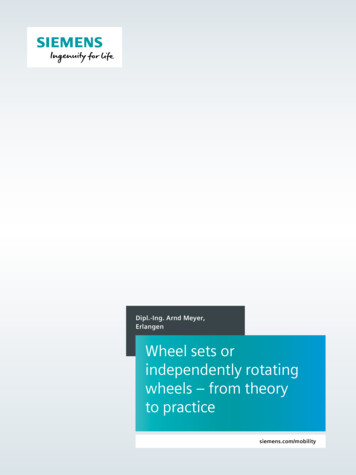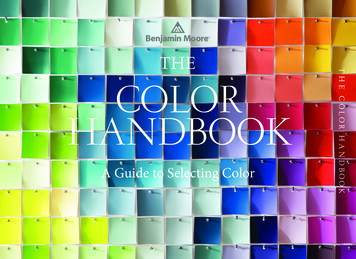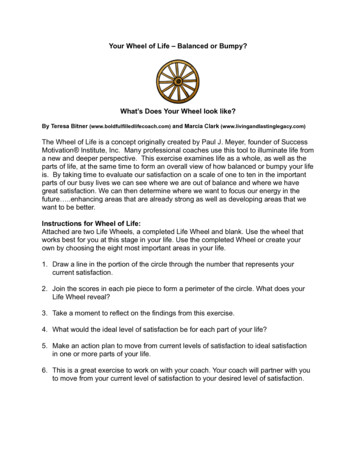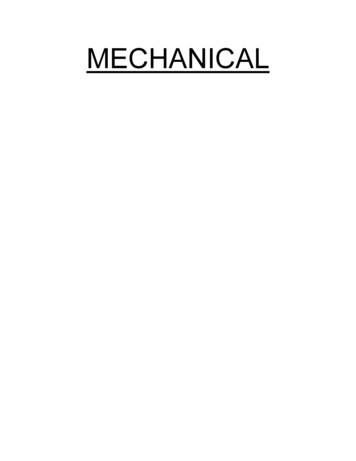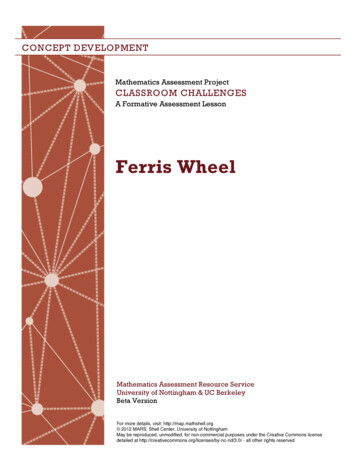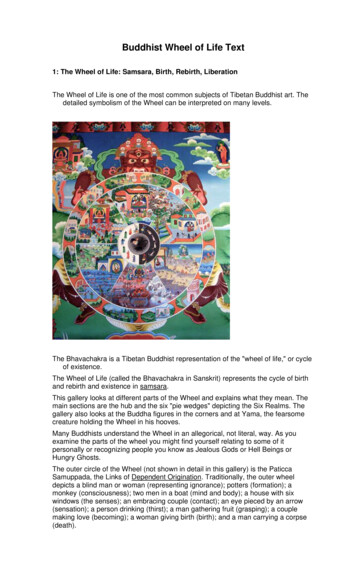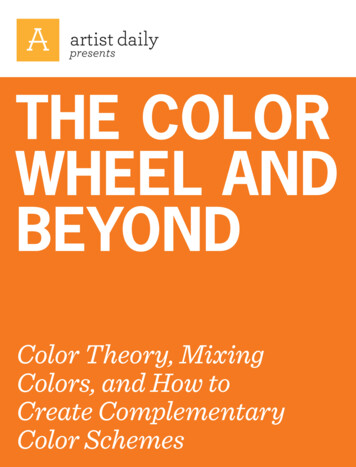
Transcription
presentsTHE COLORWHEEL ANDBEYONDColor Theory, MixingColors, and How toCreate ComplementaryColor Schemes
THE COLOR WHEELAND BEYONDItten’s original color wheel.An Introductionto Color TheoryIn the early 20th century, Johannes Itten’s theories on color changed the wayartists and scientists viewed the spectrum of colors in the world around them.Here, we outline some of Itten’s basic tenets—many of which are still employedby artists today.by Naomi EkperiginThis content has been abridged from an original article written by Naomi Ekperigin. F W Media, Inc. All rights reserved.F W Media grants permission for any or all pages in this premium to be copied for personal use.2www.artistdaily.com
THE COLOR WHEELAND BEYONDSwiss painter and teacher JohannesItten was a pivotal member of theBauhaus, Germany’s most influentialart and design school. Founded in 1919and closed in 1933 under the threat ofthe Fascist party, the Bauhaus Schoolprimarily focused on expressionist art,design, and architecture. From 1919 to1923, Itten was the main painter at theinstitution and taught a required introductory course that focused on formand color. The theories developed andtaught in this class are still practicedby artists today and are very useful for3www.artistdaily.combeginning artists as they learn to createrich, realistic, and dynamic colors.Itten’s color wheel was a departurefrom the color wheels employed at histime. Many contained too few or toomany colors, making it either difficultto find the connections between hues,or too complicated and rigid to facilitateinstruction. Itten’s wheel containedtwelve colors: the three primary colors,the three secondary, and the six tertiarycolors.Primary Colors are the buildingblocks for all other hues, and cannot beNewborn Childby Georges de La Tour, ca. 1645, oil on canvas.Collection Musée des Beaux-Arts, Rennes, France.created by mixing any other pigments.They are blue, yellow, and red.Secondary Colors are each createdfrom two of the primaries. They areorange, green, and violet. Like the primary colors, they are equidistant fromone another on the color wheel.Tertiary Colors are formed by mixing a primary and secondary color.They are yellow-green, yellow-orange,
THE COLOR WHEELAND BEYONDCafe Terrace at Nightby Vincent van Gogh, 1888, oil,32 x 26. Collection RijksmuseumKroller-Mueller, Otterlo.4www.artistdaily.comred-orange, red-violet, blue-violet, andblue-green.The artist’s most notable impact onpresent-day color theory was the association of certain colors with specificemotions. His book The Art of Colorwas a synopsis of his teachings at theBauhaus, and was groundbreakingin its study of colors’ impact on theviewer. Like other artists and theoristsbefore him, Itten studied colors scientifically as well as artistically. What sethim apart from his contemporaries wasthe use of psychoanalysis to inform histheories. He looked at the way colorsimpacted a person, as well as individuals’ perceptions of color.To the artist-educator, there werefour “qualities” of a color: hue, intensity, value, and temperature. Hue isgenerally defined as a source color, oneof the twelve basic colors on the colorwheel. Knowing the root hue allowsone to mix the color that he or she seesusing a basic palette. Value is the lightness or darkness of the color relative towhite, black, and gray. Intensity is thebrightness or dullness of a color, oftendetermined by the amount of white orcomplement has been mixed with it.It is measured relative to the brightestcolor wheel hue that is closest to thecolor. Often the words chroma andsaturation are used interchangeablywith intensity. Temperature, to Itten,was the idea of a color being “warm”or “cool”—terminology still used byartists.Itten was also one of the first todevelop successful methods of creating striking color contrasts. His sevenmethods were the contrast of saturation, contrast of light and dark, contrastof extension, complementary contrast,simultaneous contrast, contrast of hue,and the contrast of warm and cool.Saturation relates to the degreeof purity of a color. The contrast ofsaturation is the juxtaposition of pure,intense colors and dull colors. This
THE COLOR WHEELAND BEYONDVirgin of the Chancellor Rolinby Jan van Eyck, 1435, oil on wood, 26 x 24.Collection the Musée du Louvre, Paris.5www.artistdaily.com
THE COLOR WHEELAND BEYONDReading by Lamplightby James McNeill Whistler, 1858,etching and drypoint printed in blackink on ivory laid paper, 6 13 16 x4 9 16. Collection The New YorkPublic Library, New York, New York.6www.artistdaily.comcan be seen in Georges de La Tour’sNewborn Child as the women’s brightclothes, illuminated by candlelight,offer a sharp contrast to the dull background colors.Contrast of light and dark is createdwhen, as the name suggests, light anddark values of a color are juxtaposed.The most obvious examples of this arepen-and-ink and graphite drawingsas well as etchings and prints. Youcan see this at work in James McNeillWhistler’s Reading by Lamplight.The contrast of extension, alsoknown as a contrast of proportion, isbased on the relative areas of two ormore areas of color, such as large andsmall, or much and little. In PieterBrueghel’s Landscape With the Fall ofIcarus, this contrast is at work in thejuxtaposition of a large body of bluewater and a small patch of sky.A complementary contrast existswhen two complementary colors (colors that are opposite each other on thecolor wheel) are placed side-by-side. Janvan Eyck’s Virgin of the Chancellor Rolin,the red and green motif (in the robe,lectern, and angel’s wing) is Itten’s primary example of this contrast.Simultaneous contrast occurswhen opposing colors are placed nextto each other, creating the illusion ofvibrations or shadows. In Vincent vanGogh’s Café Terrace at Night, the use ofdark blue for the figures on the terracemakes them appear to be shadows, primarily because of the contrast betweenthe light orange-yellow and dark blue.A contrast of hue is the easiest toidentify, as is created by the juxtaposition of different hues. Itten reasonsthat the intensity of the contrast diminishes as the hues move farther awayfrom the primary colors. The mostextreme example of this contrast isred/yellow/blue, and can be seen inAlessandro Boticelli’s Lamentation Overthe Dead Christ With the Saints Jerome,Paul, and Peter.
THE COLOR WHEELAND BEYONDThe contrast of warm and cool iscreated when colors that are considered“warm” or “cool” (as defined by Itten)are juxtaposed. Warm colors such asred, orange, yellow, and browns evokea feeling of warmth and comfort, andare attractive to the viewer. As a result,objects painted this color appear tomove forward. Cool colors, such asblue, green, and grays, recede intothe background. Psychologically, Ittenfound that they were associated withsadness and melancholy. Many of thegreat Impressionist painters employedthis contrast in their landscapes. InCamille Pissarro’s work, red/brown/orange in architectural features likehouses and churches are often juxtaposed with cool skies, establishingdepth and perspective for the viewer.When viewing works of art, mostviewers see these contrasts at work, butdo not know how to identify them. Foran artist, knowledge of the basic tenetsof color theory can help him or herevoke emotion and leave an impact onthe viewer. And just as Itten’s methodscan be adopted to yield certain effects,they can also be subverted to shock theviewer and show subject matter in startling ways. nABOVELamentation Over the DeadChrist With the Saints Jerome,Paul, and Peterby Alessandro Botticelli, ca. 1495,tempera on panel, 42 x 28. Collection theMuseo Poldi Pezzoli, Milan.LEFTLandscape with the Fall of Icaruscopy of original by Pieter Brueghel, ca. 1558,oil on wood, 29 x 44. Collection the MuseesRoyaux des Beaux-Arts de Belgique, Brussels.7www.artistdaily.com
THE COLOR WHEELAND BEYONDStill Life of Egg and Glassby Jacob Stevens, 2007, oil on board, 24 x 18. Private collection.Working with aComplementary PaletteWorking with a complementary palette can lead toharmonious paintings and the creation of clear, vibrant colors.by Naomi EkperiginThis content has been abridged from an original article written by Naomi Ekperigin. F W Media, Inc. All rights reserved.F W Media grants permission for any or all pages in this premium to be copied for personal use.8www.artistdaily.com
THE COLOR WHEELAND BEYONDFor many artists, choosing a palettecan be difficult. Each poses differentsets of benefits and challenges, and itcan take time to learn to maximize apalette’s effectiveness. A palette canbe made with as few as three colors,and traditional painting is taught withthe rule that the primary colors red,yellow, and blue can be used to makeall other hues. However, there areseveral options for creating harmonious, visually pleasing paintings usinga variety of palettes. For some, usingcomplementary colors (those oppositeone another on the color wheel) offersa viable alternative to a traditionalpalette. “Using only two families ofcolor (complementary colors) willnaturally give your paintings strengthand harmony,” says Joyce Washor inher book Big Art, Small Canvas: PaintEasier, Faster, and Better With Small Oils(North Light Books, Cincinnati, Ohio).“An infinite number of colors can bemixed with the hues in complementarypalettes.” Washor first began workingwith a complementary palette morethan 10 years ago as a student at theWoodstock School of Art, in New York,when she took a class with painterHongNian Zhang. “I was getting a lotof muddy color mixtures, and I foundusing a complementary palette alleviated this problem--although it took meabout two years to really get the hangof it.” The three different palettes sheuses are red/green, yellow/purple, andblue/orange, which she employs whenworking in both oil and watercolor. Shedetermines her palette based on theoverall mood of the scene or still life.Washor now teaches several workshops a year on this technique, andasserts that while it may seem simple,9www.artistdaily.comthe palette is actually quite complex.“It’s the theory of the complementarypalette that makes it so effective. It’sbased on the idea of yin and yang,” shesays. “All aspects of painting can beinterpreted this way: value (dark versuslight); composition (up and down orleft to right); color temperature (warmversus cool); color intensity (soft versusstrong); and color hue (green versusred, orange versus blue, and yellowversus purple).” The artist paints portraits, landscapes, and still lifes, andnow primarily paints miniature works.“Small paintings have taught me theart of careful color observation,” shenotes in her book. “An object may notbe immediately recognizable just by itssize, so the color has to be representational in order to identify it.” Whenpreparing a setup, she considers whichobjects would fit in the color schemeshe wishes to work in—her favorite isred/green.
THE COLOR WHEELAND BEYOND“In my workshops, the first thingI do is have the students make a colorchart,” Washor says. “For example,I lay out all the reds and greens ifthat’s the palette we’re working with,and have them mix them so that theyhave an idea of the full range of colorsavailable.” Washor’s red/green paletteconsists of chrome green, permanent green light, Winsor green, sapgreen, raw umber, bright red, chromeorange, permanent rose, Indian red,purple madder alizarin, blue black, andPermalba white; her preferred brand isWinsor and Newton. “I explain to students that there are some colors they10www.artistdaily.comaren’t going to get. For example, with ared/green palette, a truly vibrant blue isnot possible. However, the blue you doget will maintain the harmony of thepainting, and when the viewer sees it inrelation to the other colors in the pieceit will appear blue.” Washor also notesthat there seem to be a wider range ofgrays when working with this type ofpalette.Jacob Stevens, an artist based inTucson, Arizona, began working witha complementary palette for the samereasons as Washor. “I am a professional video game artist, but I work intraditional media such as oil as a wayThree Onionsby Joyce Washor, 2007,watercolor, 3 x 4. Collection the artist.Washor used an orange/blue palettefor this piece.
THE COLOR WHEELAND BEYONDof exploring my technique beyond thedigital realm,” he explains. “I had beentaught that the primary colors red,yellow, and blue could be used to mixany color. That just didn’t seem trueto me—the colors I mixed using theprimary colors were dull and muddycompared to the premixed colors Ibought at the store.” About a year ago,Stevens began experimenting withalternative color palettes in an attemptto save money on tube colors, as wellas to simplify his color mixing yet stillcreate colors that were full of life. Ofhis several experiments, he has foundthe complementary color palette to bethe most intuitive. “I’m also no longerintimidated by the wide variety of colors offered in art stores because I know11www.artistdaily.comI can make any of those colors usinga complementary palette,” he adds.Stevens classifies himself as a traditional realist painter, and, like Washor,finds his palette suits a whole host ofsubjects.Complementary palettes are effective for creating rich color becausecolors appear most vibrant when placednext to their complements. In much ofWashor’s work the results of a complementary palette are many neutral tonesspiked with contrasting bursts of colorand bright highlights—highlights tempered by their complements, which tiethe composition together even tighter.Using complementary colors can alsodraw the viewer’s eye to your focalpoint. When mixing colors, WashorOverturned Vaseby Joyce Washor, 2007, oil painting.
THE COLOR WHEELAND BEYONDrecommends using a palette knife toadd colors in very small amounts. “Ifyou add too much paint and the coloris too far off, discard the pile and startagain, but save the pile for future use,”she says in her book. “Ninety percentof the time I find that it’s applicableto another part of the painting. This isanother advantage of the complementary palette. Colors are so harmoniousthat even mistakes are usable.” One ofthe biggest challenges artists face withthis palette is training their eyes to seethe subtle nuances in color temperature and intensity. Working slowly andtaking ample time to study a subjectbefore picking up a brush helps an artist become more familiar with thesesubtle variations over time.Overall, both Washor and Stevensfind that a complementary palette hasfar more benefits than disadvantages.“It takes time to learn to master anykind of palette,” says Washor. Thosewho are interested in experimentingwith a set of complementary colorsshould be open, patient, and willing totake risks as they discover new ways torender their favorite subjects. n12www.artistdaily.comMeltonby Jacob Stevens, 2007, oil paintingon board, 18 x 25. Private collection.
THE COLOR WHEELAND BEYONDSix Color PrismaticPalette: Cadmium RedLight, Alizarine Crimson,Cadmium Yellow Pale (orCadmium Yellow Lemon),Cadmium Yellow Medium(or Yellow Ochre),Ultramarine Blue, CobaltBlue, plus Ivory Blackand Titanium White.Color Mixing Secretsfor the Plein Air Painterby John HulseyPainting outdoors on location posesunique challenges compared to thewell-controlled studio environment- no question about that! With theexplosion of interest in plein air painting, there has been a commensurateincrease of interest in educationalworkshops taught by experienced artists. Perhaps this is because upon beginning to paint outdoors, one quicklyrealizes how difficult and frustrating itcan be to create even a small, pleasingpicture from hours spent hard at work.There is so much to learn, and thequickest way to get there is to studywith someone who has spent yearslearning the ins and outs of landscapepainting. We teach plein air workshopsin order to help cut years off of theplein air learning curve for our students. This article shows the uniquemethod that we have developed andthat we teach our workshop studentsto quickly analyze the local color andvalues, premix all the colors neededfor the whole painting and develop aconsistent color harmony among thepremixed colors.Every successful plein air painter wehave come across uses a disciplined,systematic approach to analyze thesubject in front of them, simplify it,and then restate it in painterly terms.This is how we approach the task ofmixing correct values and harmoniouscolor relationships:This content has been abridged from an original article written by John Hulsey. Hulsey Trusty Designs, L.L.C., All rights reserved.Used with permission by F W Media, Inc. Permission is granted for any or all pages to be copied for personal use13www.artistdaily.com
THE COLOR WHEELAND BEYONDGreensecondarymixed fromCad. YellowLight andCobalt Blue.STEP ONEArrange the colors on your palette,from warm to cool as shown on previous page. We recommend that youread our article: The Educated Paletteat www.theartistsroad.net first and bethoroughly familiar with all the concepts there. After you have done this,mix the three secondaries from theprimaries in your palette. To save timein the field, we suggest that you mixthese secondaries up in advance inyour studio.Over time, you will arrange yourprimary colors to your liking. Asshown here, I have moved my reds andyellows around a bit to reflect my ownpreferences, but I still keep the warmsand cools separated so that I can reachfor them without thinking about wherethey are. Once you arrive at the optimalarrangement, don’t change it and yourbrush will always find the right color.This green mix is perfect - neither tooblue nor too yellow.Why mix secondaries when wecan easily buy them ready-made?We believe that the only way to trulyunderstand color relationships isto experience mixing them. Theconfidence and speed you get fromknowing which colors will make whatmixed tone and how colors affect eachother will automatically improve mixed fromCad. RedLight andCadmiumYellow Light.Violetsecondarymixed fromQuinacridoneRose andUltramarineBlue. To geta cleaner,brighterviolet, I addedQuinacridoneRose to mypalette.
THE COLOR WHEELAND BEYONDTake your time when mixing thesecondaries! It is very important tomix them so that they do not leantoward one or the other primary.They should sit right in the middle.Compare them to the pure primariesas you mix, using your palette knifelike a trowel or cake spatula to smooththe colors into each other with a flat,sawing motion. Then place them inyour palette where you can cross-mixthem to develop those beautiful grays.15www.artistdaily.comSTEP TWOOnce you have located your subjectand set up your gear, develop aneffective composition and get thatdrawn on your canvas or board. Ifyou are unsure of how to achievethis, refer to our article, The Artist‘sRoad Guide to Composition atwww.theartistsroad.net, for exactinformation.My painting subject inAbiquiu, New Mexico.
THE COLOR WHEELAND BEYONDSTEP THREEUsing your palette knife, premixthe colors in your landscapesubject. We suggest that you firstmix only the one or two largestmasses of color, which youdetermine by squinting. As youmix these base colors, constantlycompare them in value to yoursubject. This process is madesimpler by the use of a sightthrough gray scale, as shown.First match the actual observedvalue of your major masses to apoint on the scale, and then mixyour color to match that grayvalue, using a palette knife. Justhold up your brush or paletteknife with the mixed color on itin front of the scale and adjustit until it matches the value youhave determined is correct.You will want to use the grayscale for every plein air painting.To modify it like the one we use,see, Perspectives No. 86, Hit theRight Values Every Time. In thispainting, one of my main massesis green, which is a secondarycolor, and the other mass is violet,another secondary, so this is aneasy-to-understand example of ourbasic principles.ABOVEMy gear andfinished studyABOVEGetting the values rightwith the sight-throughgrey scale.16www.artistdaily.com
THE COLOR WHEELAND BEYONDSTEP FOURPlacing your two piles of accurately mixed base color in yourpalette as shown, start blending one into the other. Use theflat of a large palette knife with a sliding, sawing motionto do this. Move a small amount of color A over to color Bwhere you’ll get some of that mixed in and then work thatback toward A again. Repeat this operation until you havea gradated set of colored grays that represent all the varioustones of the two colors as they change in hue from A toB. You have just harmonized your two base colors to eachother!617www.artistdaily.comPremixed colors on my palette.
THE COLOR WHEELAND BEYONDSTEP SIXPaint the entire picture with onlythese colors, not adding newcolors after this point. They willstick out like a sore thumb. If yourun out of a color, stop and remixit the same as before. Over timeyou’ll get a sense of how muchpaint to mix up front. My originaltwo base colors now work as purehues, while all the other mixes aregradations of those main tones. Itis a simple matter at this point toadd white to any of these colorsto effect a tint or highlight, or addblack to make an accent. Note:when you need a large quantity ofhighlight color, start with a pileof white paint first, and then addsmall amounts of your premixedcolor to it, not the other wayaround. You’ll avoid wasting lotsof white paint this way. nWhere I used thepremixed colors inthis painting.18www.artistdaily.comSTEP FIVELet’s take this a step further and create some more harmonizedgrays on either side of our two main colors. I like to usecomplementaries or even tertiary colors to do this, so that I canget a nice range of cools and warms. In this example, I’ve usedCadmium Orange to the left of A, and Alizarine Crimson to theleft of B, and mixed them with my knife as above. Look at thosebeautiful grays! Joaquin Sorolla said that “the money is in thegrays”, and he was right. 90% of our paintings should consistof colorful grays such as these, with only touches of pure colorshere and there to bring it all together. These are now all the colorsI will need to complete my painting, and because they all sharesomething of each other, they are all in harmony together.
Itten’s color wheel was a departure from the color wheels employed at his time. Many contained too few or too many colors, making it either difficult to find the connections between hues, or too complicated and rigid to

